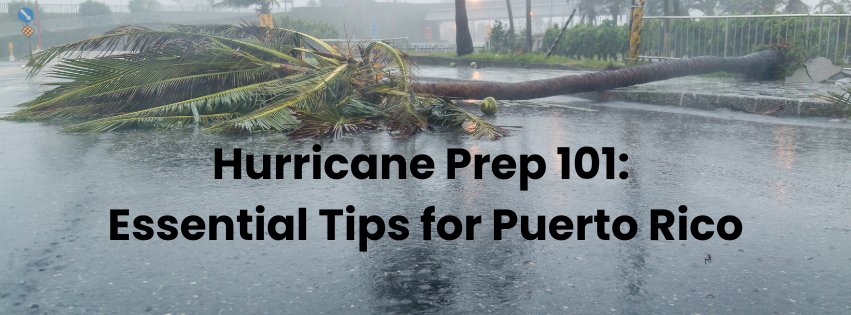
Hurricanes: One of the Few Downsides to Life in Puerto Rico
Puerto Rico is a beautiful Caribbean island territory with gorgeous beaches and year-round warm weather—a paradise by all accounts.
It’s fun to visit Puerto Rico, but living there is even better. From all over the United States and even the world, business owners and individuals take advantage of its many tax incentive programs to relocate to the island. Most expats settle in the San Juan area, and there are beautiful cities to choose from all over the island.
However, it’s not just tourists and prospective residents who visit Puerto Rico. The entire island is also vulnerable to tropical storms and hurricanes. Recent examples include Hurricane Fiona in 2022 and Hurricanes Irma and Maria in 2017.
What Are Hurricanes?
Hurricanes are storms that form over warm ocean waters, with winds of at least 74 mph that can sometimes exceed 157 mph. Each hurricane receives a rating, or category, from 1 to 5. The higher the number, the stronger the storm, and the more likely it is to cause damage from flooding, strong winds, and storm surges if it comes ashore.
It’s typical to see about a dozen such storms appear each year in the Atlantic Ocean. They’re the dark lining to the silver cloud that is life in Puerto Rico.
Puerto Ricans know how to weather hurricanes—it’s part and parcel of living on the island. However, if you’re from a place where hurricanes aren’t a big risk, you may not know proper hurricane preparation procedures.
If you’re planning to visit Puerto Rico and make it your home, here’s what you should know to protect yourself, your loved ones, and your home from tropical storms and hurricanes.
When Is Hurricane Season in Puerto Rico?
Hurricane season in Puerto Rico officially begins on June 1 and ends on November 30. The peak of hurricane season typically falls between August and October, with September being the month when hurricanes are most likely to strike.
How to Learn about a Developing Storm
The National Oceanic and Atmospheric Administration (NOAA) maintains the National Hurricane Center website, which provides up-to-date information about developing tropical storms and hurricanes. You should find out whether an impact is likely at least five days in advance, giving you time to finish your storm preparations. Don’t wait until the last minute to get started on these.
Check the National Hurricane Center website often during hurricane season and come up with a plan to evacuate or shelter in place long before a storm is bearing down. Keep an NOAA weather radio and extra batteries in your emergency kit.
Puerto Rico Weather during Hurricane Season
Overall, Puerto Rico weather is much more uniform than what you may be used to on the mainland. During hurricane season, average daytime temperatures often reach the mid- to high 80s. July and August are the hottest months. Temperatures for most of the island remain within a range from 65 to 90 degrees all year. Most of the year, there’s little difference between daytime and nighttime temperatures in the San Juan metro area.
The island sees the most rain during the summer, with up to seven inches of rain in a single month. San Juan gets more rain than the southwestern and northwestern parts of the country. The northern and eastern coasts tend to feel more humid than the southern coast.
Preparing for Hurricanes in Puerto Rico
Buy a Generator and Stock Up on Gas
There’s a good possibility you’ll lose electricity when a hurricane strikes. Depending on the severity of the storm and your location, it may take several days, weeks, or even months before power is restored. Buy the smallest possible generator that will meet your needs—most people only need something to power a fan, charge a few devices, and keep a small refrigerator cold.
Prepare an Emergency Supplies Kit
Assemble your emergency supplies kit early on and keep some of the contents in sealed plastic bags to minimize the risk of water damage during a hurricane. Priority items should include water and non-perishable food that will last for at least three days for each person in your household. FEMA suggests essentials such as a battery-powered or hand crank radio, NOAA Weather Radio with tone alert, flashlights, extra batteries, first-aid kit, matches, multi-tool with can opener, masks, hygiene supplies, daily medications, and important documents in a waterproof container.
Stock Up on the Right Groceries
It’s wise to stock up on extra food items well in advance. Consider items such as gallons of water, canned meat, fish, fruit, and vegetables, canned or boxed milk, pasta, oatmeal, rice, coffee, and peanut butter.
Protect Your Pets
Don’t forget about your pets’ needs. Purchase additional pet food, medications, and other supplies for your pets. Ensure your contact information is current on any of their microchips and collars.
Keep a Go-Bag in Case You Need to Evacuate
Each family member should have their own bag with a change of clothes, daily medications, device chargers, and copies of important documents. Keep a week’s worth of cash on hand as well.
Stay Safe After the Storm
If you evacuated, don’t re-enter your home until it has been inspected and declared safe. Throw away any food in your fridge and any other foodstuffs exposed to floodwater. Don’t drink tap water until you know it’s safe. Boil it or use a purifying system if you don’t have bottled water on hand.
Protect Against Insects
Bug populations multiply in the standing water after a hurricane. Wear long-sleeved shirts and pants and use EPA-registered insect repellent to protect against floodwater mosquitoes. Be prepared for an explosion of fire ants after a hurricane as well.
Puerto Rico Residents May Be Eligible for Assistance
In the wake of a hurricane, keep an eye out for a White House major disaster declaration. Residents of the island may be eligible for federal aid, such as grants for temporary housing and home repairs as well as low-interest loans to cover property losses. You can register online for assistance or call 1-800-621-FEMA (3362).
How Hurricanes May Affect Your Bona Fide Residency Status
As an Act 60 tax incentive decree holder, you may be able to receive credit for up to 14 days of presence in Puerto Rico toward your 183-day requirement, regardless of whether you were on the island or traveling abroad.
Final Thoughts: Be Ready Before Hurricanes Visit Puerto Rico
It’s stressful when hurricanes visit Puerto Rico, but you can do a lot to secure yourself, your loved ones, and your property if you stay informed and prepared. Don’t let hurricane season in Puerto Rico dissuade you from relocating to this Caribbean paradise. The threat of these storms is dwarfed by the enormous advantages of starting a new chapter of your life in Puerto Rico.
